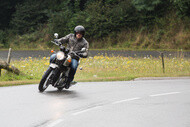This is a question that may seem trivial, but it will be at the centre of your preoccupations if you’re starting out as a motorcyclist. There are steps to follow, behaviour to adopt and precautions to take so that you can corner with peace of mind and in complete safety. In this article, our experts share their experience and explain to you how to corner on a motorcycle. We will also explain how to make a u-turn on a motorcycle.
The different types of corners
Before getting into the meat of the matter, it is important to understand that there are different types of corners. We’ll explain further below how to corner more generally, but keep in mind that you’ll have to adapt the steps that we describe depending on the configuration of the roads, which, in some cases, will require more caution.
1 - The different angles
What distinguishes corners is the angles. As we shall see, corners have three types of radius:
Constant radius turn
As its name indicates, this is a semi-circular turn where the radius is the same from the beginning to the end.
Increasing radius turn
As you take the corner, the angle widens. We can say, then, that it’s a turn that opens up.
Decreasing radius turn
Unlike an increasing radius, the radius here shrinks. We can say, then, that it’s a turn that closes.
2 - The gradient
The angle isn’t the only variable that characterises corners. You also have to take into account the gradient. There are turns where the situation is flat, descending, or ascending, and others that have a positive crossfall (a rise after the turn) or a negative crossfall (a descent after the turn).

3 - The conditions
Finally, add to all that the driving conditions, which may require special precautions, such as, for example, the dimensions of the road (narrow or wide), the state of the road (wet, dry, potholes, leaves, etc.) and the visibility (rain, fog, etc.).
How to corner on a motorcycle in 3 steps
The particularities mentioned above require, should you be confronted with them, the highest levels of attention and precaution from you. With practice, you’ll learn to anticipate possible dangers and to adapt your conduct as a result.

The following advice deals with cornering in a general manner.
1 - Before the turn
- Always pay attention to the traffic in front and behind you
- You should be looking both at what is right in front of you and on what is coming up: you should anticipate your trajectory on the corner
- You should be concentrated
- The lower part of your body should be tightened, in contact with the bike.
- Your upper body should be more relaxed and loose.
- You should slow down slowly, using engine braking more than the brakes.
2 - During the turn
- You should be looking both right in front of you and on what’s coming up: you should anticipate the exit point
- Your head should remain vertical with respect to the ground, but your body should lean into the axis of the bike
- The arm that is on the side you’re turning should be lightly bent whereas the other should be extended
- You should feel your centre of gravity
- You should follow a trajectory on the road depending on the way in which the turn develops (if it closes, for example, take the corner with a slightly wider trajectory in the turn before moving back in right after to avoid running off the road)

3 - After the turn
- You should keep your eyes fixed on the exit of the turn to maintain a stable trajectory
- You should release the brakes
- You should accelerate gradually while straightening your bike
- Your bike and your body should go back to a vertical position
- You can relax your position for greater comfort
How to make a u-turn on a motorcycle
It may happen that you’ll find yourself at a dead end and need to make a u-turn on your motorcycle. Maybe you’re on vacation and riding on a road that’s unfamiliar, or perhaps you made a wrong turn and need to go back the way you came.
How do you make a u-turn when the road is too narrow? Here’s our advice.
1 - Choose the right moment and the right place
If you’re in a traffic area, pay attention to the other vehicles, warn them by activating your indicators or your hazard lights.
Ensure that you make your turn in an area where other drivers coming in your direction have enough visibility to be able to brake in time. Avoid, for example, making your u-turn at the exit of a corner.
2 - The manoeuvre
- Stop and look behind you, in the direction you want to go, so that you are aware of your surroundings.
- Keep one foot on the ground while you make your turn.
- Steer to turn slowly right up to the edge of the road, then counter steer and move back until the angle allows you to set off again in the opposite direction.
3 - In the mountains, never do so if there is a danger
If there’s a ravine on the side of the road, do not make a u-turn on your bike that would place you in front of the drop. If you ever by inattention release your brakes or the clutch, there is a risk the bike will surge forward, taking you with it.
Rather, make the turn on the side of the embankment. This has two advantages:
- It allows you to avoid a danger
- The embankment helps you to turn more easily: with the front wheel, slightly climb up to gain inertia. Reverse at a diagonal and then all you have to do is head off in the other direction.
Article written with the technical contribution of BMC Moto


